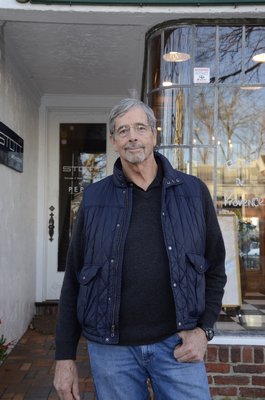
A Southampton Village-based architect on Monday said he is being forced into taking legal action against the village after he was never paid for his work in designing a now-defunct plan for a new ambulance barn on Windmill Lane.
Ric Stott, who has been an architect for 30 years, with an office just a couple of doors down from Village Hall for the past 22 years, filed a lawsuit against the village on Tuesday, seeking nearly $200,000 he says he is owed.
According to Mr. Stott, he was not paid for plans he designed for a new ambulance barn for Southampton Village Volunteer Ambulance, work completed in 2015 and 2016 under contract. The original plans were for the ambulance barn to be constructed between the Southampton Village Police station and Lola Prentice Park on Windmill Lane.
Though a few neighbors raised concerns about the location of the ambulance barn, the Village Planning Board approved the plans for the $5.5 million structure in October 2016, and the project was put out to bid.
Those bids came in too high, however, and the village hit the brakes on the project. Mr. Stott said he then decided to voluntarily reevaluate the work and redesign the project so it fit within the village’s budget.
But it may have been too late.
Instead of going with a custom-designed plan by Mr. Stott, Southampton Village Mayor Michael Irving said last week, the new approach is to look at a pre-engineered building that will fulfill the needs of the ambulance company and be under budget.
“The original design was over budget and unacceptable,” Mr. Irving said. “Since then, we have gone back to the drawing board and have mapped out our ‘real’ needs in design and approach.”
Mr. Stott said village officials never considered his redesigned plans and instead chose to look at a pre-engineered solution.
“Even if the redesign was discussed, I was not consulted,” Mr. Stott said. “This is a disservice to me and a disservice to the voters of Southampton Village who voted on a custom LEED-certified building.” “LEED” refers to Leadership in Energy and Environmental Design, a certification for “green” construction that is energy efficient.
Mr. Stott said he expressed a willingness to work with the company that would construct the pre-engineered building, but officials stopped talking to him in March and refused to answer emails. He said he was told by Mr. Irving that any communications between them has to be in an official capacity.
“Ideally, I’d love to build the building the people deserve,” Mr. Stott said. “This is absolutely, without a doubt, the most stressful thing in my life. It could bankrupt me.”
Work in the amount of $185,009 was done by Mr. Stott, according to a lawsuit that was filed with the State Supreme Court.
The $185,009 represents two invoices from January and March 2017 that have not been paid as part of Mr. Stott’s contract with the village. Along with the $185,009, Mr. Stott is also seeking interest, costs and disbursements.
On Wednesday, Mr. Irving said Mr. Stott was paid for the work he did under the contract with the Village. Mr. Irving added that any dispute Mr. Stott has involves extras that were not part of the contract and were never approved.
Village Attorney Wayne Bruyn said Mr. Stott’s contract was terminated about a month ago. A letter was sent to Mr. Stott on September 15 giving him a 30-day notice that his contract would be terminated on October 17, and two weeks after he received the letter, on September 29, Mr. Stott filed a notice of claim with the village.
Mr. Irving said the project is moving forward, and bid specs are being collected, adding that he hopes to be back on track with a more reasonable project for the village.
“There are a couple of issues that need resolving, but I feel that by late spring we should have a good feel of getting the project going,” he added.